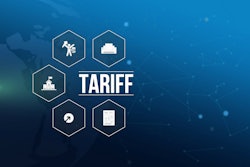
The Food Logistics team thanks you for your continued readership and support through 2024 and beyond.
Here are the Top 5 most viewed articles on our site for 2024:
45,000 Dockworkers on Strike at 36 Ports. What's Next?
In October, Marina Mayer, editor-in-chief at Food Logistics and Supply & Demand Chain Executive, reported that close to 45,000 dockworkers at 36 ports along the East Coast were still on strike as a result of the International Longshoremen’s Association (ILA) and United States Maritime Alliance (USMX) failing to reach an agreement prior to their Master Contract deadline.
“The U.S. port strikes are putting firms on edge. No one wants more U.S. supply chain chaos, least not an administration preparing for an election just weeks away. Estimates show that the strike could end up costing the U.S. economy $5 billion a day, so if this process becomes protracted, heads in DC will likely start to turn," says Alexander Style, GM, Americas at Vinturas. "Savvy retailers will have been preparing for any delays by stockpiling weeks in advance to ensure they are well buffered should any supply chain delays occur, but given lead times on globalized supply chains, anyone looking to move now will likely be too late. As we saw recently with the rail strikes in Canada, even government intervention to prevent economic shut down doesn’t guarantee anything outside the short term, let alone business returning to status quo."
Continuous Education for Logistics Professionals
Continuous education in logistics is essential for professionals aiming to stay competitive and relevant. As global supply chains increase in complexity due to technological advances, ongoing education helps professionals keep pace with new trends, tools and best practices. Whether through formal education, certifications or on-the-job training, continuous education empowers logistics professionals to drive efficiency, improve decision-making and contribute to the overall success of the supply chain. This infographic by Food Logistics breaks down continuous education in 2024 and beyond.
Butter Shortage: The Perfect Storm of Climate Change and Inflation
According to the Peace Corps, nearly 1 billion people across the world experience the effects of food insecurity. There are three aspects to food security according to the World Health Organization - food availability, food access, and food utilization. The first area of food availability is dependent on the food supply chain, which has become a punching bag for extreme weather events. Just look at 2023 – natural disasters wreaked havoc from El Niño causing unbridled rice shortages worldwide to Brazil’s droughts stifling coffee bean production. And as long as climate change runs rampant in 2024, the punches will keep coming.
The latest victim: butter.
Extreme weather is predicted for the year ahead, and resulting shortages of food commodities will continue to impact consumers on a global scale. In this article, Nari Viswanathan, senior director of supply chain strategy at Coupa, explains that it’s high time business and supply chain leaders move past considering how we got here and take action to minimize, mitigate, and prevent additional shortages.
4 Issues Impacting Agribusiness in 2024
Continued labor shortages and rising costs for farm inputs and insurance are a few of the issues those in agribusiness must contend with in 2024. Yet, even amidst these challenges, there’s room for growth. By 2027, the global food and beverage market is expected to increase to about $9.2 billion, according to Food and Global Beverages Market Report.
To stay successful in the coming year, organizations must keep abreast of the challenges and know how to contend with them. From Josh Smart, North American practice leader and chief sales officer for agribusiness, food and cannabis at HUB International, here are the Top 4 issues impacting the agribusiness market in 2024 and insights on how to address them.
Why AI and Accuracy Are a Requirement for Optimizing the Last Mile
Last mile is a critical frontier. Often considered the most complex and costly leg of the supply chain, the rise of e-commerce and increasing customer expectations for fast and reliable deliveries has highlighted this complex part of the journey.
A recent report by Extensiv found that while a majority of third-party logistics (3PL) providers still show positive order and profitability growth, a larger group of 3PLs are now seeing flat or declining profits as the economy fluctuates. The report includes that, although approximately one-third of 3PL respondents showed more than a 25% increase in order volume growth year over year and 42% indicated an increase of up to 24%, 22% of respondents either remained the same or saw a decline.
Alexis Mizell-Pleasant, managing editor at Food Logistics and Supply & Demand Chain Executive, explains how years of innovation to revolutionize the last mile has answered the call to improve these costs and drive efficiency, culminating in the latest advances in AI that synthesize analytics and tracking to transform the future of 3PL operations.




















